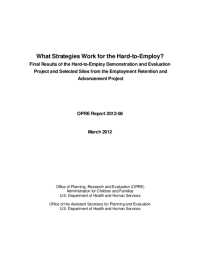What Strategies Work for the Hard-to-Employ?
Final Results of the Hard-to-Employ Demonstration and Evaluation Project and Selected Sites from the Employment Retention and Advancement Project
In the context of a public safety net focused on limiting dependency and encouraging participation in the labor market, policymakers and researchers are especially interested in individuals who face obstacles to finding and keeping jobs. The Enhanced Services for the Hard-to-Employ (HtE) Demonstration and Evaluation Project was a 10-year study that evaluated innovative strategies aimed at improving employment and other outcomes for groups who face serious barriers to employment. The project was sponsored by the Administration for Children and Families (ACF) Office of Planning, Research and Evaluation in the U.S. Department of Health and Human Services, with additional funding from the U.S. Department of Labor. This report describes the HtE programs and summarizes the final results for each program. Additionally, it presents information for three sites from the ACF-sponsored Employment Retention and Advancement (ERA) project where hard-to-employ populations were also targeted.
Three of the eight models that are described here led to increases in employment. Two of the three — large-scale programs that provided temporary, subsidized "transitional" jobs to facilitate entry into the workforce for long-term welfare recipients in one program and for ex-prisoners in the other — produced only short-term gains in employment, driven mainly by the transitional jobs themselves. The third one — a welfare-to-work program that provided unpaid work experience, job placement, and education services to recipients with health conditions — had longer-term gains, increasing employment and reducing the amount of cash assistance received over four years. Promising findings were also observed in other sites. An early-childhood development program that was combined with services to boost parents’ self-sufficiency increased employment and earnings for a subgroup of the study participants and increased the use of high-quality child care; the program for ex-prisoners mentioned above decreased recidivism; and an intervention for low-income parents with depression produced short-term increases in the use of in-person treatment. But other programs — case management services for low-income substance abusers and two employment strategies for welfare recipients — revealed no observed impacts.
While these results are mixed, some directions for future research on the hard-to-employ emerged:
- The findings from the evaluations of transitional jobs programs have influenced the design of two new federal subsidized employment initiatives, which are seeking to test approaches that may achieve longer-lasting effects.
- The HtE evaluation illustrates some key challenges that early childhood education programs may face when adding self-sufficiency services for parents, and provides important lessons for implementation that can guide future two-generational programs for low-income parents and their young children.
- Results from the HtE evaluation suggest future strategies for enhancing and adapting an intervention to help parents with depression that may benefit low-income populations.
- Evidence from the HtE evaluation of employment strategies for welfare recipients along with other research indicates that combining work-focused strategies with treatment or services may be more promising than using either strategy alone, especially for people with disabilities and behavioral health problems.






